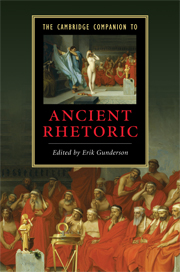Book contents
- Frontmatter
- Introduction
- Part 1 An archaeology of rhetoric
- Part II The field of language
- Part III The practice of rhetoric
- 8 Types of oratory
- 9 Rhetoric of the Athenian citizen
- 10 Rhetoric and the Roman Republic
- 11 Staging rhetoric in Athens
- 12 The drama of rhetoric at Rome
- 13 Rhetoric and the Second Sophistic
- Part IV Epilogoues
- Appendix 1: Rhetorical terms
- Appendix 2: Authors and prominent individuals
- References
- Index of passages
- Index of subjects
- Series list
13 - Rhetoric and the Second Sophistic
from Part III - The practice of rhetoric
Published online by Cambridge University Press: 28 January 2010
- Frontmatter
- Introduction
- Part 1 An archaeology of rhetoric
- Part II The field of language
- Part III The practice of rhetoric
- 8 Types of oratory
- 9 Rhetoric of the Athenian citizen
- 10 Rhetoric and the Roman Republic
- 11 Staging rhetoric in Athens
- 12 The drama of rhetoric at Rome
- 13 Rhetoric and the Second Sophistic
- Part IV Epilogoues
- Appendix 1: Rhetorical terms
- Appendix 2: Authors and prominent individuals
- References
- Index of passages
- Index of subjects
- Series list
Summary
There has been no time in history when the formal study of rhetoric, as inaugurated in the fifth century bce, has had such a pervasive impact on the education system and the culture of a society as in the so-called Second Sophistic. Rhetoric formed not only an integral and central aspect of the curriculum at all levels of study, but also the horizon of expectation in all aspects of cultural production, from statues of star performers to the language of letters between friends.
The term “Second Sophistic” was coined by the third-century ce writer Philostratus as a way of capturing his sense of how the scholars and orators of his own era looked back to the classical city for a privileged intellectual foundation. It is a useful expression in that it strongly emphasizes two important strands of the history I shall be tracing. First, the writers of the first three centuries ce show an obsessive interest in the past and in the past of the classical city in particular: they are acutely conscious of their own belated status. All the texts I will be discussing are written in the literary Attic Greek of the classical era, although the language of the streets by this period was koine, the language of the Christian Gospels. The historical examples that stud the orator’s speeches are similarly taken from events of five hundred years earlier. Social performance was calibrated by a knowledge of – and performance in – these borrowed clothes. This willful anachronism is not just a demonstration of technical flair: the imagination was formed by the concerns and figures of an era long passed. Second, the term “sophistic” marks the commitment to a form and style of learning associated with the great sophists of the classical era.
- Type
- Chapter
- Information
- The Cambridge Companion to Ancient Rhetoric , pp. 228 - 242Publisher: Cambridge University PressPrint publication year: 2009
- 2
- Cited by



